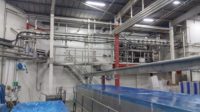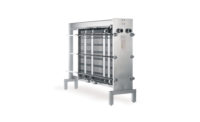Ready Foods, Inc., a Denver, Colo.-based manufacturer of soups and sauces for restaurants and meat processors, cut the time it takes to chill one of its core products by a third, thanks to a turnkey cooling system from HRS Heat Exchangers, Marietta, Ga.
The HRS solution, which is ideal for viscous materials, has enabled Ready Foods to significantly increase production of the meat marinade it supplies to a leading restaurant chain.
After receiving a large order for one of its meat marinades from a quick-service Mexican chain of restaurants, Ready Foods needed to increase capacity. The existing process of kettle cooking and steaming the marinade, then chilling it in 5-pound pouches in a water cooling system for three hours, would not allow Ready Foods to meet the customer’s increased demand for 2,000-pound totes. So, Marco Antonio Abarca, president and owner of Ready Foods, and Greg Hefter, plant engineer, set out to find an alternative solution that would enable them to decrease the length of time it took to cool the marinade from 200˚F to 38˚F and thereby increase production levels.
A simple solution
However, finding the right cooling system was no easy task.
“We are a medium-sized company, but it became clear that most of the equipment suppliers were accustomed to dealing with much larger firms than ours; their proposals were totally unsuitable for our size of operation,” says Abarca.
“Some recommended systems, which required a large footprint or a 20-foot ceiling height; others could only supply 1-2 parts of the solution and expected us to source the rest and integrate it ourselves; while some showed us systems [that] were far too complex and sophisticated for our operatives to use,” adds Hefter. “We don’t have the luxury of a team of engineers on call 24/7, so any system we chose had to be simple to operate and straightforward enough for our mechanics to take care of.”
Flexible design
Ready Foods sent HRS two versions of their marinade for testing. One was very thin while the other was a concentrated form of the product.
“At first, Ready Foods proposed cooling the thinner product using R-404 refrigerant,” says Cameron Creech, U.S. sales and engineering manager for HRS. “As that’s an aggressive cooling media, we considered a 2-stage cooling system—the first phase would cool the product with chilled water, a much-less aggressive medium; the second stage would involve chilling with ammonia.”
The original purchase order for this solution was issued in July 2017, but shortly after, Ready Foods’ client changed the brief, opting instead for the thicker product and choosing glycol rather than R-404 refrigerant as the cooling medium. HRS quickly put together a revised design, and the new purchase order was approved in September 2017.
Total support
HRS’ turnkey solution comprises a transfer pump to move the product from the cook kettles into the balance tank; a balance tank to receive and mix both recycled and new incoming product; a BP-6 hydraulic pump to push product through the system; a pre-cooler, consisting of 10 AS Series triple-tubes as the pre-cooling exchanger, which cools the product using chilled water; the final cooler, comprising two Unicus scraped surface heat exchangers; and a 3-way valve [that] sends product into the filler tank or back to the balance tank, depending on whether the temperature requirement is met or the filler tank is too full to receive product.
Hygienic operation
HRS also supplied auxiliary equipment, including a cleaning-in-place (CIP) system and a steam-powered hot water set to prevent freezing in the event of a production halt (also used to heat the solution during the automated CIP program).
From a food safety standpoint, the CIP system was crucial for Ready Foods.
“The product is very viscous, so being able to clean the scraped surface heat exchanger was vital,” says Creech. “The CIP cabinet and system incorporate a centrifugal CIP pump installed alongside the BP-6 pump. This ensures the correct velocities are met, keeping the entire system clean and hygienic.”
Setting the standard
The cooling system was commissioned in September 2018, and has been in operation ever since. The difference in the volume of product Ready Foods is now able to produce is considerable.
“It used to take us 3 hours to chill the marinade, but we are now able to cool it in just 1 hour. We’ve been able to keep up with our client’s new, increased demand, even at peak times. On a 5-day-a-week basis, we can hit 200,000 pounds,” says Abarca.
From an operational standpoint, this integrated system isn’t too complex and boasts a small footprint. In addition, due to the fact that a large percentage of Ready Foods’ employees are Spanish-speaking, HRS incorporated a feature on the main page of the program that allows the controls to be switched between English and Spanish.
“I’m surprised by how smoothly this project has gone,” adds Abarca. “It normally takes a long time to integrate a system into a factory, and that’s what I was expecting here, but that has not been the case. The cooling system has evened out the playing field by allowing a medium-sized company such as ourselves to compete with the larger firms. Not only that, but it’s the type of technology [that] suits a lot of applications. We are using it to make a meat marinade, but the reality is that we can do anything with it. For us, this is 21st century. The HRS cooling system has set the bar for us.”



